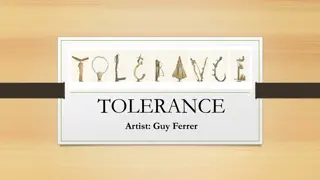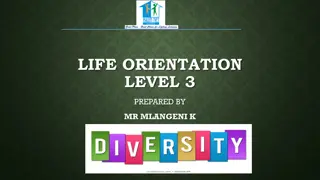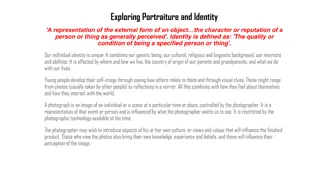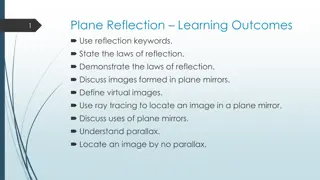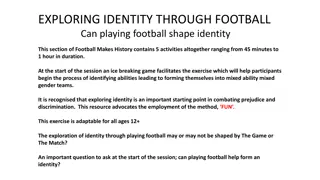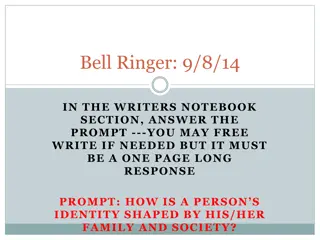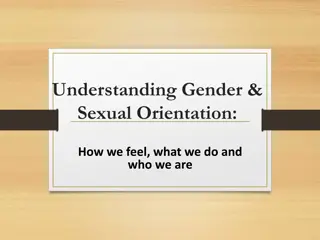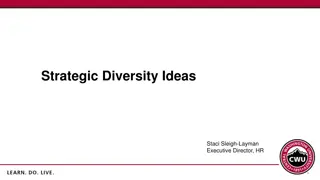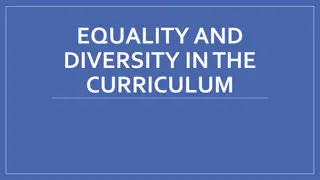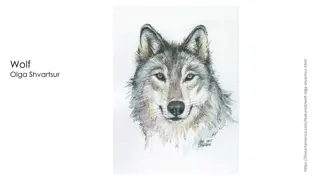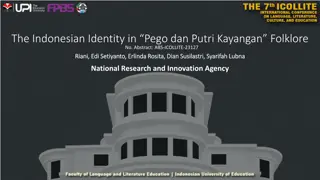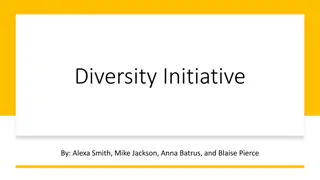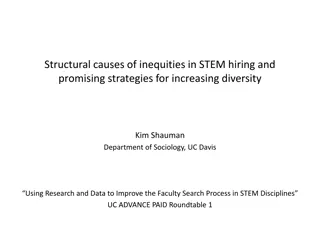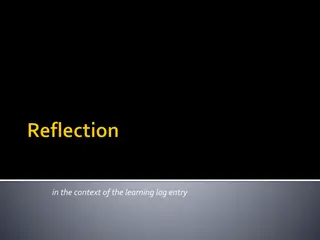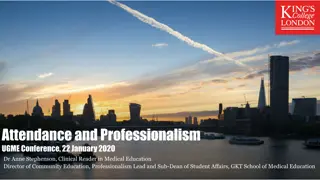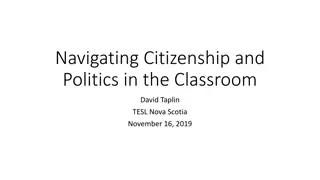Exploring Identity and Diversity Through Artwork and Reflection
Delve into the intricate relationship between experiences and identity through a series of thought-provoking prompts, insightful artist statements, and engaging discussions on prejudice and inclusivity portrayed in symbolic black and white artworks. Uncover how understanding diverse experiences can help combat biases and nurture a more inclusive community.
Download Presentation

Please find below an Image/Link to download the presentation.
The content on the website is provided AS IS for your information and personal use only. It may not be sold, licensed, or shared on other websites without obtaining consent from the author. Download presentation by click this link. If you encounter any issues during the download, it is possible that the publisher has removed the file from their server.
E N D
Presentation Transcript
Identity Identity - - expression expression through experience through experience
Think Think- -write write- -talk talk In your journal, respond to this prompt: How do our experiences shape who we are? Free write for 5 minutes When finished, you will share with your partner.
At the end of this lesson, you will be able to At the end of this lesson, you will be able to Apply symbolism to analyze a series of artwork, quotes, articles that reflect the experience of diverse individuals. Describe and explain the impact of social awareness and inclusion on our role as civic members of a community.
Seek to Understand the Experiences of Others Seek to Understand the Experiences of Others by: Gracie Cliff, Morristown, Tennessee Notice & note Using the first column of your graphic organizer, note 2 things you see in this image. Example: I see_____. This makes me think_______. "My color may not be the same, but my feelings are. quote by: Elizabeth Young, Phoenix, Arizona
Artist statement Artist statement I desire to represent people and concepts truthfully, and often find myself working in realism. In this piece I created illustrations of various people who represent my community. The people I have met throughout my academic career have shown me the importance of having a diverse society. They ve shown me a society that is respectful of all. Many societies are diverse, but the individuals within often struggle to embrace and empathize with people whose experiences are different from their own. This art piece is a call to action that causes viewers to question their biases. Are they relying on only their own experiences to shape their worldview or are they open to the views and unique experiences of others whose lives and cultures are different from their own? Understanding and dismantling bias will foster inclusivity and build a healthy and diverse community.
Discuss Discuss- -turn & talk turn & talk What are your thoughts on the artist s statement? To what extent do you agree/disagree? Why? What does the artwork and artist s statement tell us about prejudice? What can you glean from the artist s symbolic use of black and white? How might learning about individuals who are different from us help to quiet the prejudice we have about others?
Source 2 Source 2 Now we will look at a poem by Claude McKay. Pay close attention to the use of symbolism in this piece. Consider? How does McKay s relationship with America symbolize his individual experience and sense of self?
America America- -Claude McKay Claude McKay Although she feeds me bread of bitterness, And sinks into my throat her tiger s tooth, Stealing my breath of life, I will confess I love this cultured hell that tests my youth. Her vigor flows like tides into my blood, Giving me strength erect against her hate, Claude McKay, (born September 15, 1889, Nairne Castle, Jamaica, British West Indies died May 22, 1948, Chicago, Illinois, U.S.). Her bigness sweeps my being like a flood. Yet, as a rebel fronts a king in state, I stand within her walls with not a shred McKay advocated full civil liberties and racial solidarity. In 1940 he became a U.S. citizen; in 1942 he was converted to Roman Catholicism and worked with a Catholic youth organization until his death. Of terror, malice, not a word of jeer. Darkly I gaze into the days ahead, And see her might and granite wonders there, Beneath the touch of Time s unerring hand, Like priceless treasures sinking in the sand.
Discuss & write Discuss & write Consider how McKay s experiences influenced this poem How do you think he felt about America? Let s fill in the 2nd column of the graphic organizer Write 2-3 sentences describing how McKay s experiences might define his identity.
Before you go (on an index card) Before you go (on an index card) 3-2-1 3 statements of insight 2 wonderings 1 question for tomorrow
Day 2 Day 2 Make sure you have 1. Your graphic organizer 2. You journal sheet 3. Your article packet
Threat? Threat? by: Alexis Thompson, Roxboro, North Carolina Notice & note Using the 3rd column of your graphic organizer, note 2 things you see in this image. Example: I see_____. This makes me think_______. "If all are created equal, why aren't we acting that way? quote by: Christopher Nicola, Sarasota, Florida
Artist statement Artist statement This piece was done to bring awareness to the stereotypes surrounding Black men in America. It is my goal to evoke change for the young men and women of color in America so that one day they will have a fair opportunity in the United States
Discuss Discuss- -turn & talk turn & talk What are your thoughts on the artist s statement? In what ways can you relate to the struggles referenced in the artist s statement regarding people of color?
Source 4 Source 4 Now we will look at a poem by Walt Whitman. Pay close attention to the use of symbolism in this piece. Consider? How does Whitman s relationship with America symbolize his individual experience and sense of self?
I hear America Singing I hear America Singing- -Walt Whitman I hear America singing, the varied carols I hear, Those of mechanics, each one singing his as it should be blithe and strong, The carpenter singing his as he measures his plank or beam, The mason singing his as he makes ready for work, or leaves off work, The boatman singing what belongs to him in his boat, the deckhand singing on the steamboat deck, The shoemaker singing as he sits on his bench, the hatter singing as he stands, The wood-cutter s song, the ploughboy s on his way in the morning, or at noon intermission or at sundown, The delicious singing of the mother, or of the young wife at work, or of the girl sewing or washing, Each singing what belongs to him or her and to none else, The day what belongs to the day at night the party of young fellows, robust, friendly, Singing with open mouths their strong melodious songs. Walt Whitman At the age of twelve, Whitman began to learn the printer s trade and fell in love with the written word. Largely self-taught, he read voraciously, becoming acquainted with the works of Homer, Dante, Shakespeare, and the Bible. He founded a weekly newspaper, The Long-Islander, and later edited a number of Brooklyn and New York papers, including the Brooklyn Daily Eagle. In 1848, Whitman left the Brooklyn Daily Eagle to become editor of the New Orleans Crescent for three months. After witnessing the auctions of enslaved individuals in New Orleans, he returned to Brooklyn in the fall of 1848 and co-founded a free soil newspaper, the Brooklyn Freeman, which he edited through the next fall. Whitman s attitudes about race have been described as unstable and inconsistent. He did not always side with the abolitionists, yet he celebrated human dignity.
Discuss & write Consider how Whitman s experiences influenced this poem How do you think he felt about America? What are some contrasts that you notice between McKay s America, Threat?, and this poem? Let s fill in the 4th column of the graphic organizer Write 2-3 sentences describing how McKay s experiences might define his identity.
Cumulative writing activity Cumulative writing activity- -Journal prompt Journal prompt Using both pieces of artwork and a poem of your choice, answer the following prompt: How can social awareness help us understand how individuals experience the world? Reference specific elements within each piece of art.
Extension activity Extension activity- -Socratic discussion Socratic discussion Points of focus: 1. Use of symbolism 2. Artist and author s influence on pieces of work 3. Individual prejudice and world view
